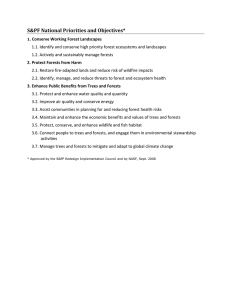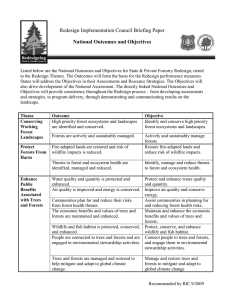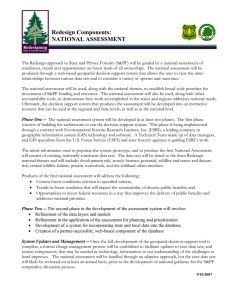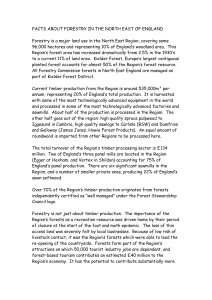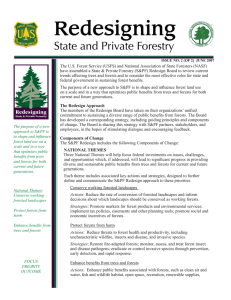The USDA Forest Service and National Association of State Foresters... assembled a State & Private Forestry (S&PF) Redesign Board to...
advertisement
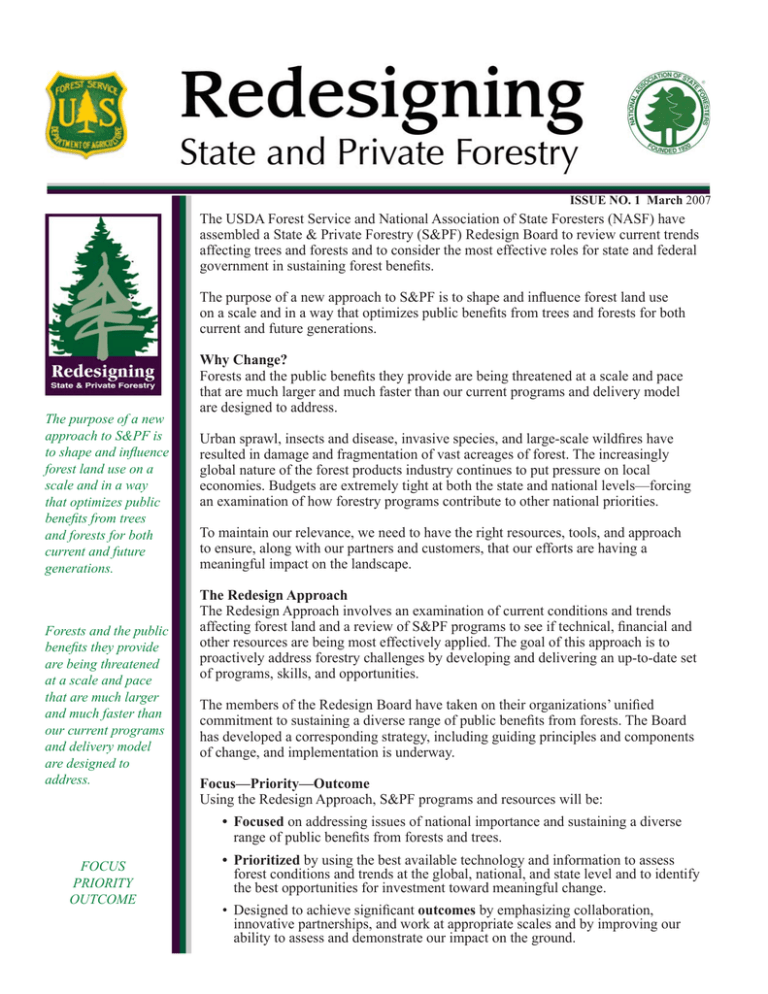
ISSUE NO. 1 March 2007 The USDA Forest Service and National Association of State Foresters (NASF) have assembled a State & Private Forestry (S&PF) Redesign Board to review current trends affecting trees and forests and to consider the most effective roles for state and federal government in sustaining forest benefits. The purpose of a new approach to S&PF is to shape and influence forest land use on a scale and in a way that optimizes public benefits from trees and forests for both current and future generations. The purpose of a new approach to S&PF is to shape and influence forest land use on a scale and in a way that optimizes public benefits from trees and forests for both current and future generations. Forests and the public benefits they provide are being threatened at a scale and pace that are much larger and much faster than our current programs and delivery model are designed to address. Why Change? Forests and the public benefits they provide are being threatened at a scale and pace that are much larger and much faster than our current programs and delivery model are designed to address. Urban sprawl, insects and disease, invasive species, and large-scale wildfires have resulted in damage and fragmentation of vast acreages of forest. The increasingly global nature of the forest products industry continues to put pressure on local economies. Budgets are extremely tight at both the state and national levels—forcing an examination of how forestry programs contribute to other national priorities. To maintain our relevance, we need to have the right resources, tools, and approach to ensure, along with our partners and customers, that our efforts are having a meaningful impact on the landscape. The Redesign Approach The Redesign Approach involves an examination of current conditions and trends affecting forest land and a review of S&PF programs to see if technical, financial and other resources are being most effectively applied. The goal of this approach is to proactively address forestry challenges by developing and delivering an up-to-date set of programs, skills, and opportunities. The members of the Redesign Board have taken on their organizations’ unified commitment to sustaining a diverse range of public benefits from forests. The Board has developed a corresponding strategy, including guiding principles and components of change, and implementation is underway. Focus—Priority—Outcome Using the Redesign Approach, S&PF programs and resources will be: • Focused on addressing issues of national importance and sustaining a diverse range of public benefits from forests and trees. FOCUS PRIORITY OUTCOME • Prioritized by using the best available technology and information to assess forest conditions and trends at the global, national, and state level and to identify the best opportunities for investment toward meaningful change. • Designed to achieve significant outcomes by emphasizing collaboration, innovative partnerships, and work at appropriate scales and by improving our ability to assess and demonstrate our impact on the ground. Guiding Principles A successful program for the nation’s forests must follow a fundamental set of guiding principles: • Be focused on public benefits of national scope and importance. • Emphasize action across boundaries and jurisdictions and on a meaningful scale. Public benefits derived from our forests, such as clean air and water, wildlife habitat, recreational opportunities, strong local economies, forest products, renewable energy, and cultural values are ecosystem services that are essential to our quality of life. • Involve prioritization of resources toward measurable outcomes. • Allow states the flexibility to address unique priorities and circumstances. • Be delivered through a more coherent and integrated suite of federal programs. • Motivate implementation through collaboration and partnerships. • Make better use of technology for planning, reporting, monitoring and communicating. • Maintain an effective level of capacity or “institutional infrastructure.” • Be supported by an up-to-date and strategically placed skill base. Components of Change The Redesign Board recommends the following components of change: • PUBLIC BENEFITS FROM FORESTS The purpose of a redesigned S&PF is to shape and influence forest land use on a scale and in a way that optimizes public benefits from trees and forests for both current and future generations. • NATIONAL GOALS / OUTCOMES Investment of federal resources will be focused on critical issues and opportunities that contribute to national goals/desired outcomes. • NATIONAL ASSESSMENT & INFORMATION SYSTEM A national assessment will identify conditions and issues to be addressed, guide goal/priority setting, and influence allocation. • STATE RESPONSE PLANS State Response Plans will be developed collaboratively under state forestry leadership to assess forest conditions and propose state actions in response to national and state priorities. This will be an ongoing process— the Board will continue to build on this approach in redesigning our programs. • PROGRAM RESOURCES Programs, staffing and related resources will be configured to positively influence and motivate landowners and communities to retain and sustainably manage forests for diverse public benefits. • RESOURCE ALLOCATION Each state will be provided a minimum level of capacity based on national goals. The remainder of available resources will be focused, through a competitive process, on projects throughout the nation that achieve measurable results toward the national goals and optimize the achievement of public benefits from forests. • MONITORING AND DEMONSTRATING RESULTS Emphasis will be placed on monitoring actions on-the-ground and using reporting and assessment information to visually and meaningfully demonstrate results. Where Can I Get More Information? Paige Lewis Redesign Project Lead paige.lewis@colostate.edu (303) 489-6534 USDA is an equal opportunity provider and employer. Debbie Pressman USDA Forest Service, State and Private Forestry dpressman@fs.fed.us (202) 205-1538


